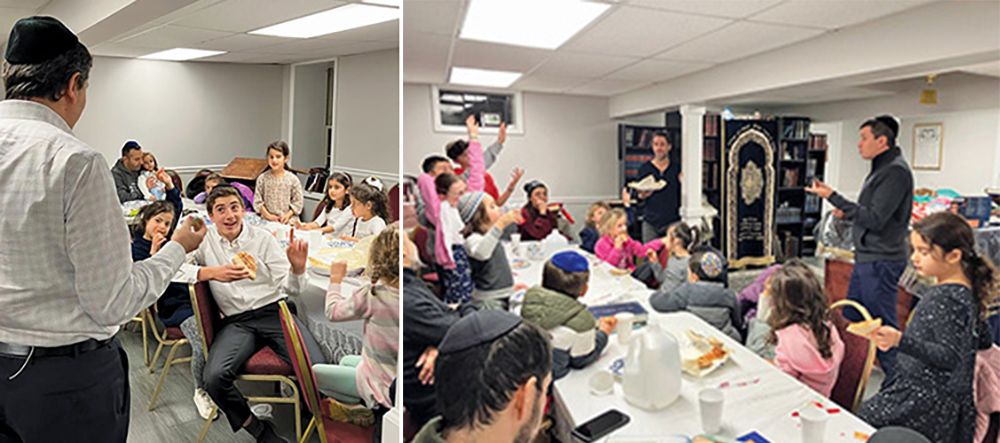By Jonathan Seliger

I recently watched a YouTube clip of an interview with one of the co-founders of Shlomo Carlebach’s iconic Haight-Ashbury synagogue known as “The House of Love and Prayer.” The co-founder related that when Reb Shlomo, zt”l was asked what ‘House of Love and Prayer’ meant, he said, and I’m paraphrasing, “It’s a place that, when you enter you’re greeted with a hug and when you leave you are missed.” I paused there for a moment and thought to myself, I know a place like that… our very own Sephardic Minyan at Congregation Bnai Yeshurun (CBY) of Teaneck.
The CBY Sephardic Minyan—let’s call it the Minyan (pronounced, in proper Sephardic parlance, “meen-yann”), is no hippie mecca to be sure, but it is a literal “house” (the Minyan meets in CBY’s detached office/house located on the shul’s property) and a figurative bayit, as in beit knesset, which is open to Yidden of all backgrounds and filled with unconditional love and undisturbed prayer.
I write this not as one of the core French, Moroccan, Tunisian or Israeli-born organizers of the Minyan, but as one of a growing contingent of what our Gabbai—and hugger-in-chief, Roi, calls, without a hint of sarcasm, “acheinu ha’Ashkenazim.” Some of said Ashkenzic brethren may have tried the Minyan looking for a change of scenery; a little more spice in their avodah. But what makes the Minyan so compelling is not the charif (spice) in the cholent, or the lively zemarim (tunes) between aliyot (berachot on the Torah); it’s the shared love and respect for the kedusha (holiness) of the beit knesset—the place, the people and most importantly, the prayer.
Friends often ask me, “why do you daven at the Moroccan minyan? You’re not Sephardi … and, wait, aren’t you Chabad?” Well, it’s true, I wasn’t born into any particular Sephardic tradition (okay, I’m a Yekke by birth). And nor do I fit the bill as a regular Lubavitcher, even though I’ve been davening Nusach Ari for most of my adult life. But apart from the common source origins between Mizrachi and Chabad nuschaot (e.g., Lurianic Kabbalah), the common denominator between the two traditions—and the answer I provide in response to the above question, is simply the feeling of achdut (unity) and the common desire to serve Hashem with joy—and that is our Minyan in a nutshell.

On Shabbat Parshat Vayeshev last year, the CBY weekly bulletin featured a piece about CBY’s then under-the-radar Sephardic Minyan, referring to it as possibly “our synagogue’s best kept secret.” While the bulletin may well have been news to some of the Minyan’s existence, for most, it was an important reminder that CBY, incredibly robust as it is, B”H, in serving our large Ashkenazic community, is also home to an eclectic group of Sephardi co-religionists who are eager to share and connect with the broader community.
An example of that sharing came just a few weeks later, on Shabbat Parshat Beshalach—Shabbat Shira, when the Minyan made its first significant foray into CBY’s main building, taking up residence Shabbat morning in the shul’s social hall. The event was a showcase of the festive Sephardi minhagim (customs) associated with Shabbat Shira on which we read, and sing, the Shirat Ha’Yam, Az Yashir and related piyutim (poems). The tefillah was well-attended by many of CBY’s Ashkenazi brethren along with honored visitors from neighboring shuls and other communities.
That morning, Acheinu Ha’Ashkenazim were privy to inspiring niggunim and pizmonim (tunes) sung by our talented local chazanim (leaders of the tefillah). To add to the atmosphere, our dedicated Minyan gabbaim (led by Roi and his brother, our sar Hatabachim, Hagai) also brought in two young guest chazanim who led Shacharit and Musaf (including Birkat Kohanim) and filled the hallowed halls with lilting layālis and stunning mawwāls.
After Musaf, the whole kehilla was treated to a grand kiddush featuring a smorgasbord of Moroccan and other North African Jewish delicacies, not least of which, a Sephardi cholent packing the punch of an army of Mahgreb spice merchants. Naturally, there were also flights of Arak and of course the odd German beer (proffered by yours truly—hey, my Yekkishe roots run deep), and the ruach (spirit) and divrei Torah continued well into the afternoon. Most importantly, the event was an amazing display of intramural achdut in which we were all very proud to play a part.
One of the many hidden gems of the Minyan is the weekly seuda shlishit. The kahal prays Mincha 20-30 minutes before the zman (time) in order to extend the late afternoon of Shabbat—a time which the Zohar HaKadosh calls “ravaderavin” (roughly meaning, “the height of Hashem’s favor”) and corresponding to Olam Haba (see Zohar Shemot 88b). The Minyan marks this holy time with a communal seuda featuring hamotzi (bread), salatim (salads), zemarim, and divrei Torah from our resident Chacham Michaël and a rotation of guest maggidim (speakers) from our vaunted CBY Rabbinate. Speaking of which, I’d be remiss if I didn’t explicitly express hakarat hatov (thanks), on behalf of myself and the Minyan, for the oversight, guidance and leadership of our CBY Mara D’atra Rav Elliot Schrier, our Rabbi Emeritus Rabbi Steven Pruzansky and the entire CBY rabbinate and administration, without which the continued growth and success of the Minyan would not be possible.

So, this is the point at which this article should rightfully have ended, however … I’m a lawyer by trade and therefore incapable of anything remotely resembling brevity, and compelled to add the following disclaimer: I want to be clear to the sophisticated Jewish Link readership that the viewpoints and attitudes expressed above are wholly my own and do not in any way reflect the views of CBY, the honored rabbinate, the Minyan, this paper or even my family (may Hashem bless them all for putting up with me). Indeed, my only interest in writing this article is to spread the good word about our CBY Sephardic Minyan. Nobody should infer from reading this that my propensity for so-called “minyan tourism,” “minhag shopping” and “nusach appropriation” is in any way a legitimate form of avoda. Maybe one day when I’ve succeeded in davening netz (sunrise) more than once a year, or completed a month’s worth of Selichot, will I even deign to consider myself a valid member of the Minyan, much less, someone who’s earned the right to eat kitniyot on Pesach!
Jonathan Seliger is a husband, father, student, teacher and aspiring simcha motivator.












